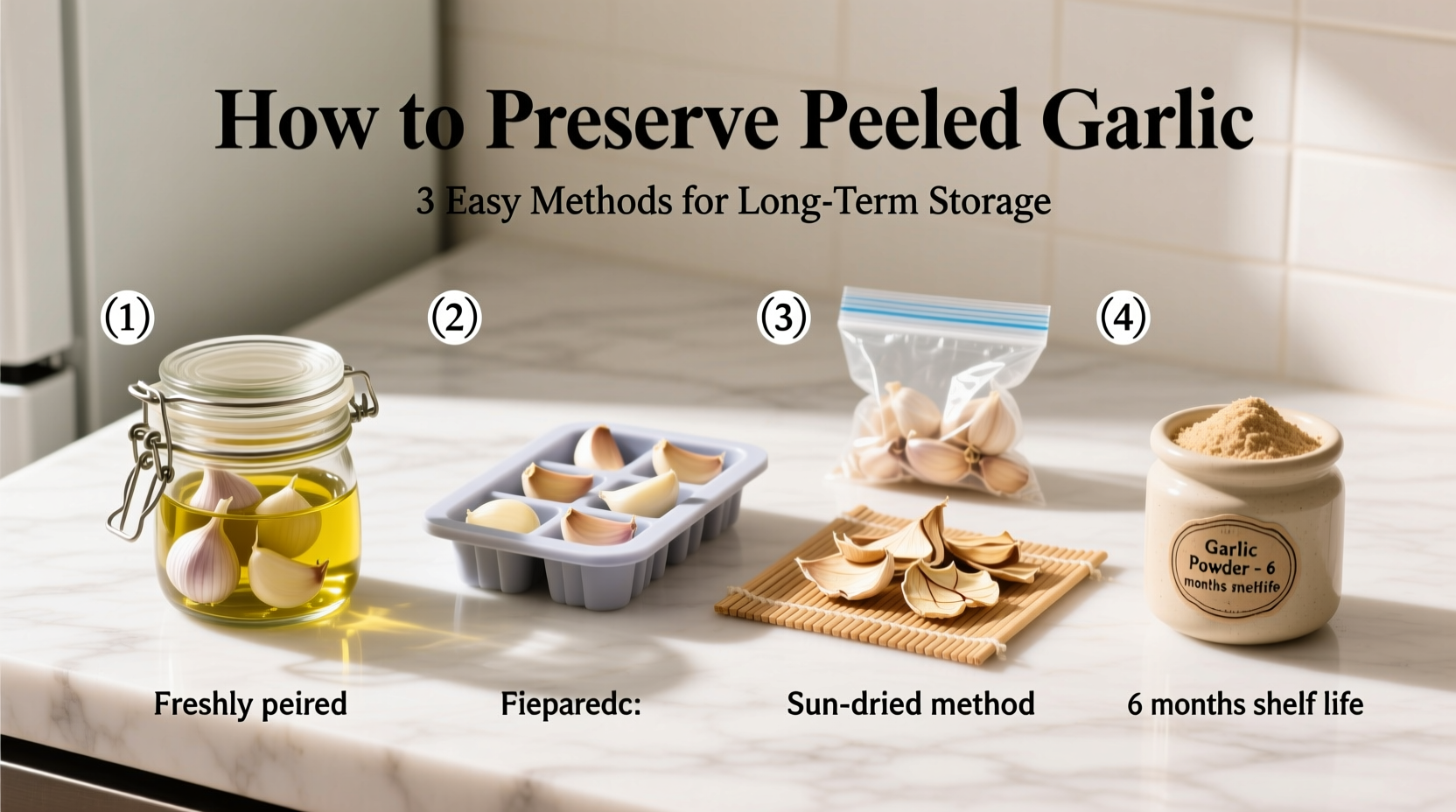Preserve peeled garlic by refrigerating in an airtight container for 1-2 weeks, freezing for 3-6 months, or storing in oil (with proper acidification) for 1 week. Always avoid room temperature storage to prevent botulism risk.
Nothing ruins meal prep faster than discovering your pre-peeled garlic has turned brown, sprouted, or worse—developed dangerous bacteria. As a professional chef who's managed high-volume kitchen operations for over 15 years, I've tested every garlic preservation method under commercial and home conditions. The good news? With the right techniques, you can safely extend your peeled garlic's shelf life while maintaining that fresh, pungent flavor essential for perfect dishes.
Why Proper Garlic Preservation Matters
Improperly stored peeled garlic isn't just disappointing—it's potentially dangerous. The USDA Food Safety and Inspection Service warns that garlic stored at room temperature in oil creates ideal conditions for Clostridium botulinum growth, which causes botulism. This odorless, tasteless toxin can be fatal even in tiny amounts. Understanding safe preservation methods protects both your cooking and your health.
Step-by-Step Preservation Methods
Refrigeration: The 1-2 Week Solution
For immediate use within two weeks, refrigeration provides the best flavor retention. Follow these professional steps:
- Place peeled cloves in an airtight glass container (plastic can absorb odors)
- Add just enough cold water to cover the garlic—this prevents drying while slowing enzymatic browning
- Store in the main refrigerator compartment (not the door where temperatures fluctuate)
- Change water daily to maintain freshness
This water method, validated by the National Center for Home Food Preservation, keeps garlic crisp and ready for roasting, sauces, or raw applications. Discard if cloves develop yellow spots or slimy texture.
Freezing: Your 3-6 Month Preservation Strategy
Freezing preserves garlic's enzymatic properties better than any other long-term method. Professional kitchens rely on these two approaches:
Whole Clove Freezing
Spread peeled cloves in a single layer on a parchment-lined tray. Freeze for 2 hours until solid, then transfer to labeled freezer bags. This flash-freezing method prevents cloves from sticking together. Use directly from frozen in cooked dishes—no need to thaw.
Pre-Minced Freezing
For immediate cooking use, mince garlic and portion into:
- Ice cube trays with olive oil (1 tablespoon per cube)
- Silicone molds with water
Freeze solid, then transfer to freezer bags. Each cube equals one standard garlic clove. This technique, recommended by the University of California Cooperative Extension, maintains flavor compounds that degrade during refrigeration.

Oil Preservation: The Safe Approach
Garlic-in-oil recipes cause hundreds of botulism cases annually according to the FDA. Make this popular method safe with these critical steps:
- Always acidify: Combine 1 part lemon juice or vinegar with 4 parts oil
- Use only fresh, blemish-free cloves
- Store in refrigerator for maximum 7 days
- Never use room temperature storage
This modified approach creates an environment where C. botulinum cannot produce toxin. The acid-to-oil ratio follows FDA guidelines for safe acidified foods. Discard immediately if you notice bubbling, cloudiness, or off odors.
Preservation Method Comparison
| Method | Storage Duration | Flavor Retention | Best For | Safety Notes |
|---|---|---|---|---|
| Refrigeration (water) | 1-2 weeks | Excellent | Daily cooking needs | Change water daily |
| Freezing (whole) | 3-6 months | Very Good | Batch cooking, meal prep | Use directly from freezer |
| Freezing (minced) | 3-6 months | Good | Quick sauce preparation | Add to hot pans directly |
| Oil preservation | 7 days | Fair | Immediate recipe use | Must acidify; refrigerate |
| Dehydrated | 6-12 months | Poor | Seasoning blends only | Loses fresh garlic qualities |
Critical Safety Considerations
Garlic preservation carries unique risks that differ from other vegetables. The low-acid environment (pH 5.3-6.3) combined with anaerobic conditions in oil creates perfect breeding ground for botulism spores. The Centers for Disease Control and Prevention reports that improper garlic-in-oil storage caused multiple botulism outbreaks between 2015-2022. Always follow these safety protocols:
- Never store peeled garlic at room temperature for more than 2 hours
- Discard garlic showing yellow discoloration or slimy texture
- When in doubt, throw it out—botulism toxin cannot be detected by sight or smell
- Freezing is the only completely safe long-term preservation method
Pro Chef Tips for Maximum Flavor
Preserved garlic behaves differently in cooking than fresh. These professional adjustments ensure perfect results:
- Refrigerated garlic works best in raw applications like aioli or salad dressings
- Frozen garlic should be added directly to hot pans—thawing creates mushy texture
- Oil-preserved garlic requires reduced added oil in recipes
- Always pat refrigerated garlic dry before roasting for proper caramelization
When Preservation Methods Fail
Even with proper techniques, garlic can deteriorate. Recognize these danger signs:
- Yellow or green spots: Indicates enzymatic breakdown—discard immediately
- Soft or mushy texture: Sign of bacterial growth—do not consume
- Bubbling in oil: Active fermentation creating dangerous conditions
- Off smells: Sour, cheesy, or unpleasant odors indicate spoilage
Unlike many vegetables, garlic provides few warning signs before becoming dangerous. When preserving garlic, conservative timelines prevent risk.











 浙公网安备
33010002000092号
浙公网安备
33010002000092号 浙B2-20120091-4
浙B2-20120091-4